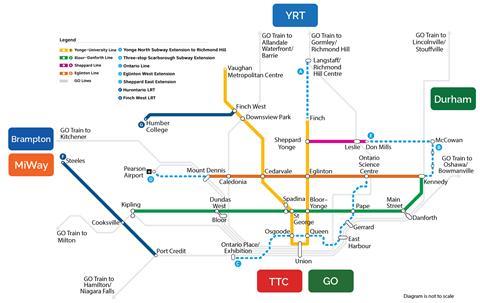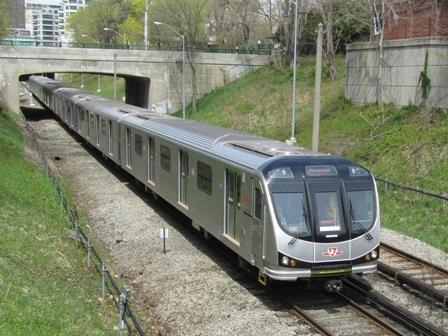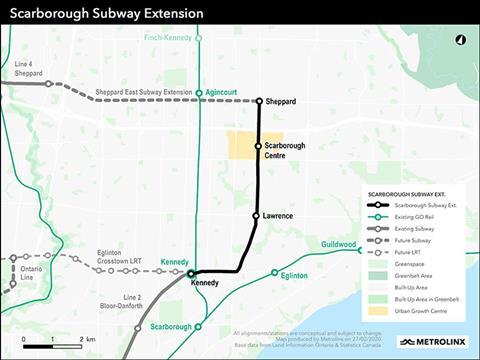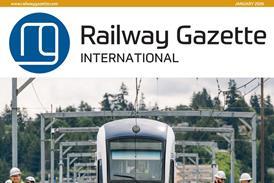
CANADA: Federal funding to cover 40% of the C$26·8bn cost of four ‘shovel-ready’ public transport projects in the Greater Toronto Area was announced on May 12.
Infrastructure Canada said this was a ‘once-in-a-generation’ investment in the area, which has 20% of Canada’s population and the third highest public transport ridership in North America.
Ontario Line

The federal government will contribute up to C$4·02bn towards the C$10·9bn Ontario Line metro, which will run for 15·6 km from Exhibition Place in the west through the city centre and northeast to the Ontario Science Centre. This is intended to alleviate overcrowding on the Yonge – University Line 1. Interchange will be provided to Line 1, the Bloor–Danforth Line 2, the future Eglinton Crosstown LRT and GO Transit rail services.
The project is expected to reduce greenhouse gas emissions by 14 000 tonnes per year and result in 28 000 fewer cars on the road daily.
Eglinton Crosstown West

The federal government will contribute up to C$1·87bn towards the Eglinton Crosstown West Extension. This would take the Crosstown light rail Line 5 now under construction a further 9·2 km west, running mainly underground from Mount Dennis to Renforth Gateway in Mississauga.
The project is intended to improve connectivity, provide congestion relief, support increased public transport modal share, and reduce dependency on private vehicles along the corridor. It is expected to reduce greenhouse gas emissions by 39 000 tonnes per year.
Plans are also being explored with the Greater Toronto Airports Authority to extend the line by a further 4·7 km to Pearson International Airport.
Yonge North Subway Extension

Subject to submission of updated project information for formal review and Treasury Board approval, the federal government will provide up to C$2·24bn for the Yonge North Subway Extension which will extend metro Line 1 by 8 km north from Finch to Vaughan, Markham and Richmond Hill, adding four stations.
Providing connections to local rail and bus services, the extension would reduce journey times between the Yonge Street and Langstaff Road area and downtown Toronto from 70 min to 48 min. This scheme is expected to reduce greenhouse gas emissions by 4 800 tonnes per year.
‘York Region’s number one transit infrastructure priority will spur economic recovery, provide greater access to other rapid transit lines, serve urban growth centres and support a sustainable future’, said Mayor of Markham, Frank Scarpitti
Scarborough Subway Extension

The federal government will contribute up to C$2·26bn towards the three-station Scarborough Subway Extension of Line 2 by 7·8 km from Kennedy to Lawrence Avenue East, Scarborough Centre and Sheppard Avenue East.
This will replace the current Scarborough automated rapid transit system, which is expected to reach the end of its useful life in 2023. The project is predicted to reduce greenhouse gas emissions by 10 000 tonnes per year.
Funding requirements
Federal funding was dependent on conditions including:
- a substantive environmental review and approval process;
- assessment of how to drive down emissions (for example by using low carbon construction material, construction best practice and reducing emissions from operations) and be resilient to the impacts of climate change;
- building affordable housing near transit oriented development;
- accessibility for persons with disabilities;
- early community involvement and inclusive consultation processes;
- measures to maximise high quality jobs and benefits for communities, including hiring targets of at least 10% for historically disadvantaged communities, equity-seeking groups, Black, Indigenous and people of colour, with possible higher targets based on an assessment of local representation;
- ensuring contractors have in place an anti-racism strategy;
- mitigating the negative impacts of project construction and operations.
‘Public transit is at the heart of a clean, inclusive recovery’, said Minister of Infrastructure & Communities Catherine McKenna. ‘Today we are making the largest investment in public transit in the GTA’s history, helping to kick-start our economy and create tens of thousands of jobs as part of the government’s plan to create one million jobs. It will help get cars off the road, and the residents of Canada’s largest community, especially essential workers, women, immigrants and youth, get around in faster, cleaner and cheaper ways. And it will help drive Canada to a net zero emissions future. This historic investment is good for the city, the region and for Canada.’








